Arabian Bedouin Traditional Savvy
Drawing upon the timeless wisdom of the Arabian Bedouin, one can uncover a treasure trove of traditional savvy that has stood the test of time. Their intricate knowledge of the desert landscape, survival skills, and unique cultural practices offer a window into a world shrouded in mystique and resilience.
As the sun sets over the dunes, the secrets of the Bedouins whisper through the wind, inviting exploration into a realm where tradition and innovation intertwine seamlessly.
Key Points
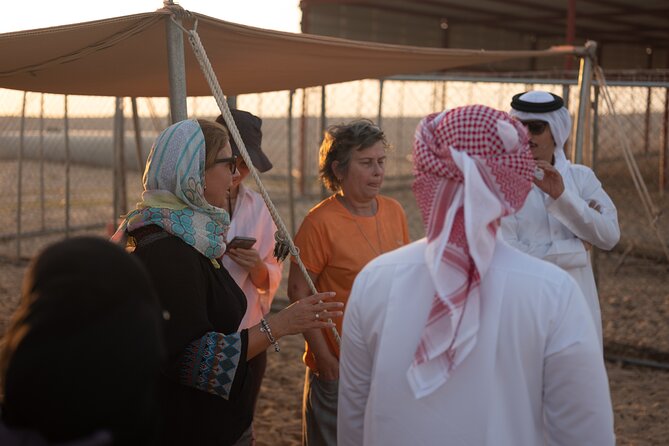
- Bedouin tribes’ mastery of camel transportation for travel, sustenance, and companionship.
- Bedouin hospitality deeply rooted in values, welcoming guests with generosity and protection.
- Traditional Bedouin clothing features intricate embroidery, vibrant colors, and flowing fabrics.
- Bedouin cuisine reflects a rich heritage with bold flavors, fusion of traditional and modern influences.
Here's some more nearby activities we've reviewed
Bedouin Tribes in Arabian Deserts
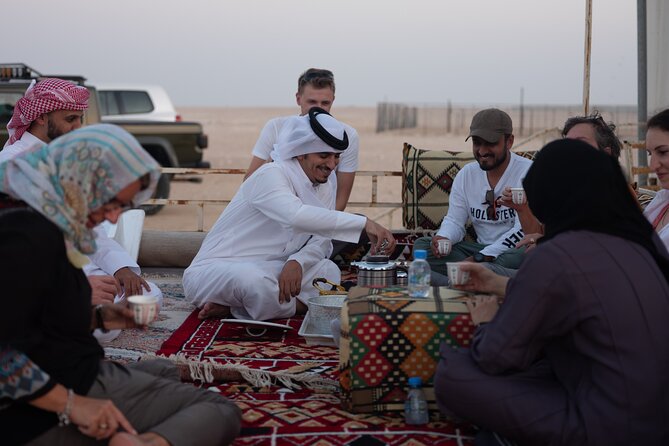
Roaming the vast expanses of the Arabian deserts, Bedouin tribes have long thrived amidst the harsh yet captivating landscapes, embodying a rich nomadic heritage that has endured through generations.
Their traditional architecture and settlements reflect a deep understanding of their environment, with tents made from goat hair providing shelter against the scorching sun and harsh winds.
Bedouins are renowned for their mastery of camel transportation, utilizing these majestic creatures not only as a means of travel but also as a source of sustenance and companionship in the unforgiving desert.
The bond between the Bedouin tribes and their camels is a testament to their resilience and resourcefulness in adapting to the challenges of the arid desert terrain.
Nomadic Lifestyle and Traditions
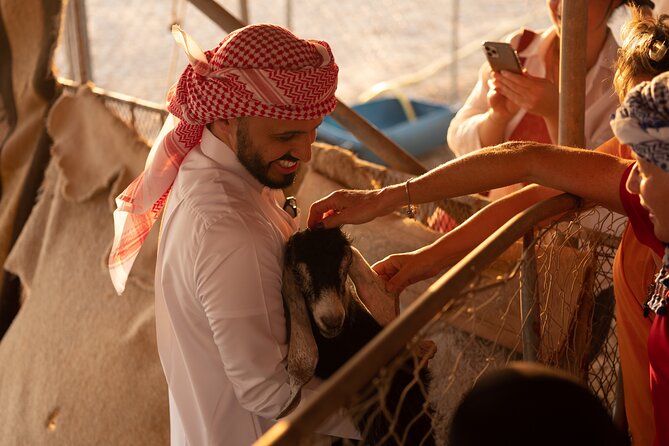
Embracing a centuries-old heritage, the Bedouin nomads of the Arabian deserts intricately weave their daily lives with time-honored traditions and a deep connection to the land.
-
Bedouin architecture, settlements: The traditional black goat-hair tents known as ‘bait al-sha’ar’ are iconic symbols of Bedouin architecture, easily movable to accommodate their nomadic lifestyle.
-
Bedouin camel racing, sports: Camel racing is a popular traditional sport among Bedouins, showcasing their skill in breeding and training these majestic animals.
-
Close-knit community: Bedouin tribes maintain a strong sense of community, relying on each other for support and companionship in the harsh desert environment.
-
Resourceful survival techniques: Their nomadic lifestyle demands resourcefulness, with knowledge passed down through generations on finding water sources and navigating the vast desert terrain.
Bedouin Hospitality and Culture
In Bedouin culture, hospitality isn’t just a tradition but a way of life deeply rooted in their values and beliefs. Bedouin hospitality practices are characterized by generosity towards guests, where visitors are welcomed with open arms, provided with food, shelter, and protection. It’s considered a societal norm to treat guests with the utmost respect and kindness.
On top of that, the cultural significance of Bedouin storytelling traditions plays a crucial role in preserving their heritage and passing down knowledge from generation to generation. These stories often revolve around themes of honor, bravery, and the importance of community bonds, reinforcing the values that are cherished within Bedouin society.
Traditional Bedouin Clothing and Accessories
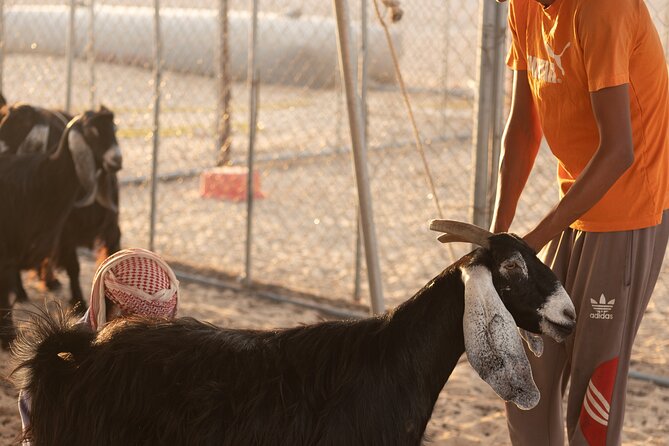
Traditional Bedouin clothing and accessories reflect centuries-old craftsmanship and cultural significance in every intricate design and material choice. Bedouin fashion is a fascinating blend of practicality and artistry, with each garment telling a story of tradition and heritage. Textile techniques passed down through generations are used to create stunning garments that aren’t only beautiful but also functional in the harsh desert environment. The use of vibrant colors, intricate embroidery, and flowing fabrics is a hallmark of Bedouin attire, showcasing their appreciation for beauty and elegance in everyday life.
- Bedouin clothing is intricately embroidered with traditional motifs.
- Textile techniques like hand-weaving and dyeing are central to Bedouin fashion.
- Accessories such as ornate jewelry and headscarves play a vital role in Bedouin attire.
- Fabrics like wool, cotton, and silk are carefully chosen for their quality and durability.
Bedouin Cuisine and Culinary Delights
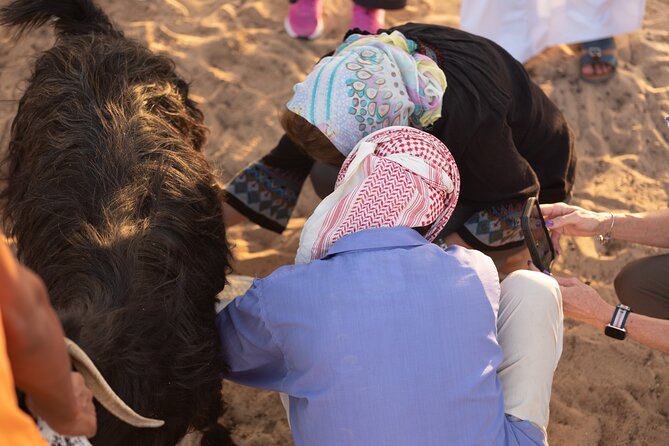
With a rich heritage deeply intertwined with the desert landscape, Bedouin cuisine captivates the senses through its bold flavors and time-honored cooking techniques.
Bedouin culinary fusion showcases a blend of traditional Bedouin dishes with modern influences, creating a unique dining experience that celebrates both history and innovation.
From hearty lamb stews cooked slowly over open fires to aromatic rice dishes infused with fragrant spices, Bedouin culinary delights offer a taste of authenticity and cultural richness.
In modern dining experiences, Bedouin cuisine continues to evolve, incorporating new ingredients and cooking methods while staying true to its roots.
Whether enjoying a meal in a traditional tent setting or at a contemporary restaurant, visitors can savor the flavors of Bedouin cuisine and enjoy a culinary journey unlike any other.
Bedouin Music, Dance, and Entertainment
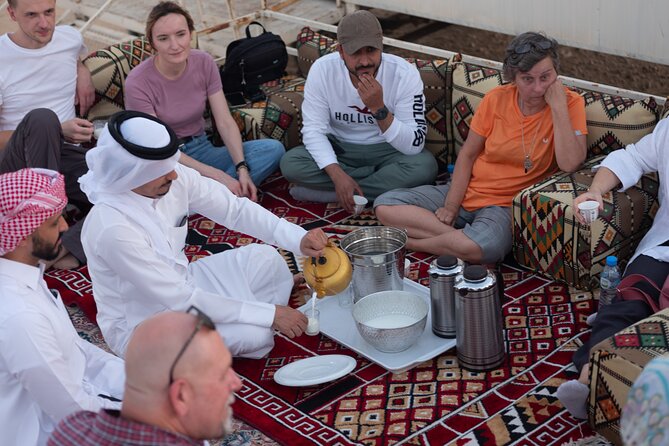
Captivating the spirit of the desert-dwelling Bedouin culture, music, dance, and entertainment play a vibrant role in showcasing the community’s traditions and heritage. Bedouin musical instruments and storytelling are central components of their cultural expression. Through rhythmic beats and melodic tunes, these traditional instruments accompany tales of valor, love, and life in the desert.
Bedouin desert festivities and celebrations are marked by lively music, where the rhythmic sounds of drums and flutes fill the air, creating an atmosphere of joy and togetherness. Dance is also a significant part of Bedouin entertainment, with graceful movements reflecting the fluidity of the desert sands. Whether around a campfire or during special occasions, music, dance, and storytelling bring the Bedouin community together in a celebration of their rich heritage.
Ancient Bedouin Crafts and Artistry

Craftsmanship among the ancient Bedouin tribes flourished as a cornerstone of their cultural identity and survival in the harsh desert environment. Bedouin artistic techniques were deeply rooted in tradition, with skills passed down through generations. These nomadic people excelled in intricate weaving, pottery, and metalwork, reflecting their connection to the land and their need for practical yet beautiful objects.
Bedouin storytelling was also a prominent art form, with tales woven into their crafts, creating pieces rich in cultural significance and history. The Bedouin architectural heritage can still be seen in the ruins scattered across the desert, showcasing their mastery of construction using local materials. These crafts and artistry not only served utilitarian purposes but also preserved the Bedouin way of life through creativity and storytelling.
Bedouin Survival Skills and Adaptations
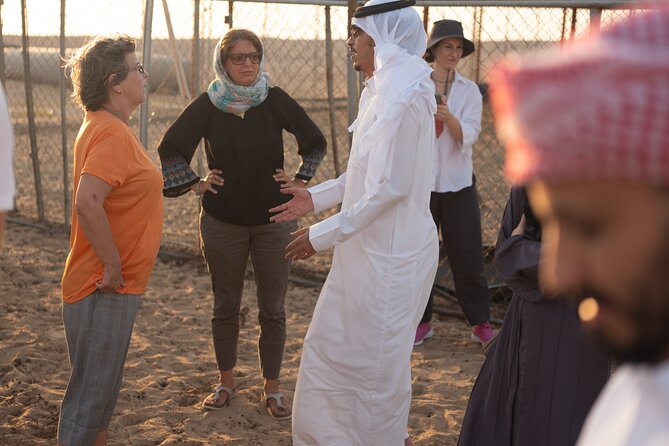
Surviving in the unforgiving desert landscape, the Bedouin people honed a remarkable array of skills and adaptations essential for their existence and thriving within the arid terrain. These desert dwellers developed ingenious methods to overcome the challenges posed by their harsh environment.
Some of the key Bedouin survival techniques and desert adaptations include:
- Water Conservation: Bedouins are adept at conserving water, crucial for survival in arid regions.
- Navigation Skills: Mastering the art of navigating through the vast desert with minimal resources.
- Animal Husbandry: Utilizing animals like camels for transportation, milk, and meat, essential for sustenance.
- Traditional Shelter Building: Constructing portable and efficient shelters to protect against extreme weather conditions.
These adaptations showcase the Bedouins’ resilience and deep understanding of their environment, allowing them to thrive in the challenging desert landscape.
Here's a few more nearby tours and experiences we have reviewed.
Common questions
How Does Modern Technology Impact the Traditional Lifestyle of Bedouin Tribes in Arabian Deserts?
Modern technology, like smartphones, has revolutionized Bedouin tribes’ traditional lifestyle in Arabian deserts. The integration of technology in tents has enhanced communication, access to information, and connectivity with the outside world, reshaping their cultural practices.
What Are the Main Challenges Faced by Bedouins in Preserving Their Nomadic Lifestyle and Traditions in the Modern World?
In preserving their nomadic lifestyle, Bedouins face challenges such as adapting to modernization while preserving traditions. Balancing change and heritage is crucial. The struggle lies in maintaining cultural identity amidst evolving societal norms and technological advancements.
How Do Bedouins Balance Their Traditional Hospitality Practices With the Influx of Tourists in Their Communities?
When balancing traditional hospitality practices with tourist interactions, Bedouins prioritize cultural preservation while fostering meaningful cultural exchange. Their ability to maintain authenticity while adapting to modern influences showcases a delicate harmony between tradition and tourism.
What Are Some Unique Aspects of Bedouin Cuisine That Set It Apart From Other Middle Eastern Cuisines?
When exploring Bedouin cuisine, one can appreciate its unique flavors and preparation methods. Culinary customs showcase a blend of tradition and innovation, reflecting the cultural integration of the Bedouin people.
How Have Bedouin Music and Dance Evolved Over Time to Incorporate Modern Influences While Still Maintaining Their Traditional Roots?
Bedouin music has evolved by embracing modern influences while preserving its traditional roots. The evolution of music and dance fusion showcases a blend of contemporary elements with age-old customs, creating a unique and vibrant cultural expression.
Here's more of our most recent tour reviews happening neaby
- Doha: Combo Doha and Lusail Private Guided Tour With Pickup
- Half Day Story Behind Doha City Tour (Private)
- Doha City Tour And Dhow Boat Ride (Private Tour)
- Private 4-Hour Shore Excursion in Doha With Entrance to 1 Museum Included
- Half-Day Private Safari Tour With Camel Ride, Dune Bashing, Star Gazing
- Doha Private City Tour With Transit & Layover From Airport
- Private Shuttle Bus Service From Al Wakra to Sealine Beach
- Private Dunes Bashing
- Romantic Tour In Al Wakrah
- Private Transfer From Doha City to Doha (Doh) Airport
- Overnight Private Desert Safari With Buffet Dinner and Camel Ride
Last Words
To sum it up, the Arabian Bedouin culture is a fascinating tapestry of traditions, customs, and skills that have been honed over generations. From their nomadic lifestyle in the deserts to their intricate weaving techniques and legendary hospitality, the Bedouins offer a glimpse into a world that’s both ancient and enduring.
Their rich heritage of music, dance, cuisine, and craftsmanship is a testament to their resilience and adaptability in the harsh desert environment. The Arabian Bedouins truly embody the spirit of tradition and innovation.